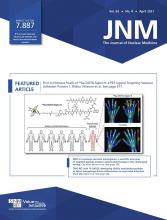TO THE EDITOR: The study by Martin et al. (1) comparing PET/MRI and PET/CT suffers from several methodologic concerns. Most importantly, all patients underwent PET/CT first and PET/MRI next. It is known that many malignant lesions will continue to increase target-to-background 18F-FDG uptake with delayed imaging (2,3). This methodologic flaw could have been mitigated by randomly alternating the order of PET/CT and PET/MRI. The absence of such randomization biases the outcome of this comparison in favor of higher sensitivity for PET/MRI. The authors did not comment as to how many of the additional 155 lesions identified by PET/MRI were due to improved conspicuity in the PET images, as shown in Figures 5B and 5E, versus improved soft-tissue characteristics, as seen in Figure 3. The case in Figure 3 was from a patient with prostate cancer, for which 18F-FDG PET is known to be less sensitive (4) and for which prostate-specific membrane antigen–labeled PET tracers will afford improved sensitivity versus 18F-FDG (5). Next, why were the 2,686 non–whole-body PET/MRI studies, representing 2.6 times more subjects than the whole-body studies, excluded from comparison? Were these also due to “technical challenges” with the MRI exam? Next, of the 29 lesions (2.9% of the total) found only by PET/MRI that were associated with a correction in the TNM stage, how many could have been expected to significantly alter the patient’s treatment outcome had the initial PET/CT results been relied on? The authors have stated that the use of PET/MRI reduced the average radiation dose by 36% (3.9 ± 1.3 mSv) compared with PET/CT scans using low-dose CT technique. If minimizing radiation dosimetry were a priority advocated by the authors, it is unclear why more than 80% of patients in the study underwent full-dose and not low-dose CT scans. The question could be asked as to the expected outcome benefit associated with an average 3.9-mSv reduction in absorbed dose by using PET/MRI in the targeted population of cancer patients, let alone in any patients (6). Finally, it is unlikely that a favorable cost benefit could be justified for more widespread use of PET/MRI in lieu of PET/CT, based on the small incremental improvement in lesions detected by PET/MRI as reported in this study.
Footnotes
Published online Oct. 9, 2020.
- © 2021 by the Society of Nuclear Medicine and Molecular Imaging.







